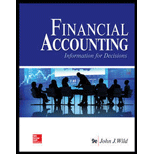
Concept explainers
Provide the names of two (a) asset accounts, (b) liability accounts, and (c) equity accounts.
Concept Introduction:
Assets are physical as well as intangible resources of the business which are kept forproviding future economic benefits.Liabilities are dues or amount payable by the business. Equity represents the sum of capital and profits/ loss earned by the business owners. Net asset is the amount of assets available after payment of liabilities.
To indicate: The names of two assets, two liabilities, and two equity accounts.
Explanation of Solution
Assets: Assets are physical as well as intangible resources of the business which are kept providing future economic benefits. The names of two assets accounts are as follows:
- Equipment: Equipment is an asset purchased for production.
- Land: Land is a long term asset.
Concept Introduction:
Assets are physical as well as intangible resources of the business which are kept for providing future economic benefits. Liabilities are dues or amount payable by the business. Equity represents the sum of capital and profits/ loss earned by the business owners. Net asset is the amount of assets available after payment of liabilities.
To indicate: The names of two assets, two liabilities, and two equity accounts.
Explanation of Solution
Liabilities: Liabilities are dues or amount payable by the business. The names of two liabilities accounts are as follows:
- Accounts payable: Accounts payable is a short term liabilities for payment of purchases.
- Long term loan: Long term loan is a long term liability for payment of loan.
Concept Introduction:
Assets are physical as well as intangible resources of the business which are kept for providing future economic benefits. Liabilities are dues or amount payable by the business. Equity represents the sum of capital and profits/ loss earned by the business owners. Net asset is the amount of assets available after payment of liabilities.
To indicate: The names of two assets, two liabilities, and two equity accounts.
Explanation of Solution
Equity: Equity represents the sum of capital and profits/ loss earned by the business owners.
Net assets: A net asset is the amount of assets available after the payment of liabilities. The names of two equity accounts are as follows:
- Common stock: Common stock represents the amount of investment made by the business owners.
- Retained earnings: Retained earnings represent the accumulated net income of the business.
Want to see more full solutions like this?
Chapter 2 Solutions
Loose Leaf for Financial Accounting: Information for Decisions
- Financial Accountingarrow_forwardPlease give me true answer this financial accounting questionarrow_forwardRefer to the Hartley Ltd statement of cash flows for the year ended 31 December 2022 and answer the following questions: 1.1 Calculate the following: 1.1.1 Depreciation 1.1.2 Interest paid 1.1.3 Net increase (decrease) in cash 1.1.4 Cash balance as at 31 December 2022. 1.2 Comment on the following: 1.2.1 Cash flows from operating activities of (R390 000) 1.2.2 Cash flows from investing activities of R150 000 1.2.3 Increase in inventory of (R700 000) 1.2.4 Increase in receivables of (R500 000).arrow_forward
 Auditing: A Risk Based-Approach to Conducting a Q...AccountingISBN:9781305080577Author:Karla M Johnstone, Audrey A. Gramling, Larry E. RittenbergPublisher:South-Western College Pub
Auditing: A Risk Based-Approach to Conducting a Q...AccountingISBN:9781305080577Author:Karla M Johnstone, Audrey A. Gramling, Larry E. RittenbergPublisher:South-Western College Pub College Accounting (Book Only): A Career ApproachAccountingISBN:9781337280570Author:Scott, Cathy J.Publisher:South-Western College PubPrinciples of Accounting Volume 1AccountingISBN:9781947172685Author:OpenStaxPublisher:OpenStax College
College Accounting (Book Only): A Career ApproachAccountingISBN:9781337280570Author:Scott, Cathy J.Publisher:South-Western College PubPrinciples of Accounting Volume 1AccountingISBN:9781947172685Author:OpenStaxPublisher:OpenStax College Cornerstones of Financial AccountingAccountingISBN:9781337690881Author:Jay Rich, Jeff JonesPublisher:Cengage Learning
Cornerstones of Financial AccountingAccountingISBN:9781337690881Author:Jay Rich, Jeff JonesPublisher:Cengage Learning College Accounting, Chapters 1-27AccountingISBN:9781337794756Author:HEINTZ, James A.Publisher:Cengage Learning,
College Accounting, Chapters 1-27AccountingISBN:9781337794756Author:HEINTZ, James A.Publisher:Cengage Learning, Auditing: A Risk Based-Approach (MindTap Course L...AccountingISBN:9781337619455Author:Karla M Johnstone, Audrey A. Gramling, Larry E. RittenbergPublisher:Cengage Learning
Auditing: A Risk Based-Approach (MindTap Course L...AccountingISBN:9781337619455Author:Karla M Johnstone, Audrey A. Gramling, Larry E. RittenbergPublisher:Cengage Learning





